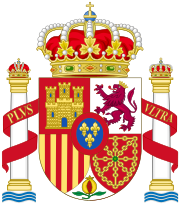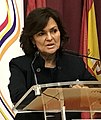Spanish government departments: Difference between revisions
←Created page with '{{Under construction|TheRichic}} {{Politics of Spain}} The '''Spanish government departments''', commonly known as '''Ministries''', are the main bodies through...' |
No edit summary |
||
| Line 52: | Line 52: | ||
| Minister attached to the Prime Minister || |
| Minister attached to the Prime Minister || |
||
* [[Joaquín Garrigues Walker]] (5 April 1979 - 2 May 1980) |
* [[Joaquín Garrigues Walker]] (5 April 1979 - 2 May 1980) |
||
* [[Rafael Arias-Salgado y Montalvo]] (17 January 1980 - 2 May 1980) |
* [[Rafael Arias-Salgado|Rafael Arias-Salgado y Montalvo]] (17 January 1980 - 2 May 1980) |
||
* [[Pío Cabanillas Gallas]] (8 September 1980 - 26 February 1981) |
* [[Pío Cabanillas Gallas]] (8 September 1980 - 26 February 1981) |
||
* [[Jaime Lamo de Espinosa]] (1 December 1981 - 29 July 1982) |
* [[Jaime Lamo de Espinosa]] (1 December 1981 - 29 July 1982) |
||
| Line 66: | Line 66: | ||
|} |
|} |
||
== Internal organization == |
|||
{{Main|General State Administration#Central Organization}} |
|||
Ministries may have [[Secretary of state#Spain|'''Secretariats of State''']] and, exceptionally, '''General Secretariats''' (with rank of undersecretariat) for the management of a sector of administrative activity. The executive bodies that are assigned to them are hierarchically dependent on them. The ministries have, in any case, an '''Undersecretariat''' and, depending on it, a '''General Technical Secretariat''' for the management of common services ([[Human resources|HR]], budget, assets, websites, security...). |
|||
On the other hand are the '''Directorates-General''', which are the management bodies of one or several functionally homogeneous areas. The directorates-general are organized in deputy directorates-general for the management of the competences entrusted to it. However, deputy directorates-general may be directly attached to other higher level management bodies or to higher bodies of the ministry. |
|||
=== Creation, modification and suppression === |
|||
Before of the approval of the 1997 Government Act, the Ministries and Secretariats of State had to be created by law, normally by a direct law passed by the [[Government of Spain|Government]] in the form of [[Royal Decree-Law (Spain)|Royal Decree-Law]]. After, the Governement Act allowed the [[Prime Minister of Spain|Prime Minister]] to aprove a Royal Decree [[Secondary legislation|(secondary legislation]]) designing the government structure. |
|||
Currently, the Prime Minister only creates the Ministries and some of the highest bodies (like secretariats of State and Undersecretariats) while the principal internal organization is delegated into the ministers, which develop the structure of the bodies created by the Premier or create new ones. The order of the Minister is also a royal decree signed the [[Monarchy of Spain|Monarch]] and countersigned by the minister responsible for the public administration at the proposal of the competent minister. |
|||
The lowest bodies such as deputy directorates-general are created by a Ministerial Order (ranked below the royal decree) of the competent minister. |
|||
=== Hierarchy === |
|||
The ministers are the superior heads of the department and direct hierarchical superiors of the secretaries of State. The executive bodies depend on the previous ones and they are hierarchically ordered among themselves in the following way: undersecretary, director general and deputy director general. The general secretaries have the rank of undersecretary and the technical general secretaries have the rank of director general. |
|||
Ministerial hierarchy: |
|||
* Minister. |
|||
** Secretaries of State. |
|||
*** Undersecretaries and General Secretaries. |
|||
**** Directors general and technical general secretaries. |
|||
***** Deputy directors general. |
|||
== Current ministries == |
|||
On 6 June 2018, Prime Minister [[Pedro Sánchez|Sánchez]] announced his ministers which assumed their offices on June 7.<ref>{{Cite news|url=https://www.nytimes.com/2018/06/06/world/europe/spain-government-women.html|title=Spain’s New Leader Forms Government With Almost Two-Thirds Women|last=Minder|first=Raphael|date=2018-06-06|work=The New York Times|access-date=2019-05-16|language=en-US|issn=0362-4331}}</ref> |
|||
{| class="wikitable" |
|||
! align="center" |Logo |
|||
! align="center" |Portfolio |
|||
! align="center" |Minister |
|||
! align="center" |Picture |
|||
! align="center" |First creation |
|||
! align="center" |Current name |
|||
! align="center" |Address |
|||
! align="center" |Website |
|||
|- bgcolor="efefef" |
|||
|[[File:Logotipo del Ministerio de Agricultura, Pesca y Alimentación.svg|200px]] |
|||
|[[Ministry of Agriculture, Fisheries and Food (Spain)|Agriculture, Fisheries and Food]] |
|||
|[[Luis Planas Puchades]] |
|||
|<gallery> |
|||
File:Luis Planas Puchades 2012 (cropped).jpg |
|||
</gallery> |
|||
|1900 |
|||
|1981 |
|||
|Paseo de la Infanta Isabel 1<br/>[[Madrid]] |
|||
|{{URL|https://www.mapa.gob.es/}} |
|||
|- |
|||
|[[File:Logotipo del Ministerio de Asuntos Exteriores, Unión Europea y Cooperación.svg|200px]] |
|||
|[[Ministry of Foreign Affairs (Spain)|Foreign Affairs, European Union and Cooperation]] |
|||
|[[Josep Borrell Fontelles]] |
|||
|<gallery> |
|||
File:Josep Borrell.jpg |
|||
</gallery> |
|||
|1714 |
|||
|2018 |
|||
|[[Palacio de Santa Cruz (Madrid)|Plaza de la Provincia, 1]]<br/>[[Madrid]] |
|||
|{{URL|http://www.exteriores.gob.es/}} |
|||
|- |
|||
|[[File:Logotipo del Ministerio de Ciencia, Innovación y Universidades.svg|200px]] |
|||
|[[Ministry of Science (Spain)|Science, Innovation and Universities]] |
|||
|[[Pedro Duque|Pedro Francisco Duque]] |
|||
|<gallery> |
|||
File:Pedro Duque-detail.jpg |
|||
</gallery> |
|||
|1979 |
|||
|2018 |
|||
|[[Paseo de la Castellana]] 162<br/>[[Madrid]] |
|||
|{{URL|http://www.ciencia.gob.es/}} |
|||
|- |
|||
|[[File:Logotipo del Ministerio de Cultura y Deporte.svg|200px]] |
|||
|[[Ministry of Culture and Sport (Spain)|Culture and Sport]] |
|||
|[[José Guirao|José Guirao Cabrera]] |
|||
|<gallery> |
|||
File:Jose Girao 2018.jpg |
|||
</gallery> |
|||
|1977 |
|||
|2018 |
|||
|Plaza del Rey 1<br/>[[Madrid]] |
|||
|{{URL|http://www.culturaydeporte.gob.es/}} |
|||
|- bgcolor="efefef" |
|||
|[[File:Logotipo del Ministerio de Defensa.svg|200px]] |
|||
|[[Ministry of Defence (Spain)|Defence]] |
|||
|[[Margarita Robles|Margarita Robles Fernández]] |
|||
|<gallery> |
|||
File:(Margarita Robles) Desayuno Nueva Economía Forum (40056259734) 2018 (cropped).jpg |
|||
</gallery> |
|||
|1705 |
|||
|1977 |
|||
|Paseo de la Castellana 109<br/>[[Madrid]] |
|||
|{{URL|http://www.defensa.gob.es/}} |
|||
|- |
|||
|[[File:Logotipo del Ministerio de Economía y Empresa.svg|200px]] |
|||
|[[Ministry of Economy (Spain)|Economy and Business]] |
|||
|[[Nadia Calviño|Nadia María Calviño Santamaria]] |
|||
|<gallery>File:Nadia Calviño 2018 (cropped).jpg</gallery> |
|||
|1928 |
|||
|2018 |
|||
|[[Paseo de la Castellana]] 162<br/>[[Madrid]] |
|||
|{{URL|http://www.mineco.gob.es/}} |
|||
|- bgcolor="efefef" |
|||
|[[File:Logotipo del Ministerio de Educación y Formación Profesional.svg|200px]] |
|||
|[[Ministry of Education (Spain)|Education and Vocational Training]] |
|||
|[[Isabel Celaá|María Isabel Celaá Diéguez]] |
|||
|<gallery> |
|||
File:Isabel Zelaa politikaria.jpg |
|||
</gallery> |
|||
|1900 |
|||
|2018 |
|||
|[[Calle de Alcalá]] 34<br/>[[Madrid]] |
|||
|{{URL|http://www.educacionyfp.gob.es/}} |
|||
|- |
|||
|[[File:Logotipo del Ministerio de Fomento.svg|200px]] |
|||
|[[Ministry of Development (Spain)|Development]] |
|||
|[[José Luis Ábalos Meco]] |
|||
|<gallery> |
|||
File:(José Luis Ábalos) 20180418 0556 Encuentro con José Luis Ábalos (39733985290) 2018 (cropped).jpg |
|||
</gallery> |
|||
|1832 |
|||
|1996 |
|||
|[[Paseo de la Castellana]] 67<br/>[[Madrid]] |
|||
|{{URL|https://www.fomento.gob.es/}} |
|||
|- |
|||
|[[File:Logotipo del Ministerio de Hacienda.svg|200px]] |
|||
|[[Ministry of Finance (Spain)|Finance]] |
|||
|[[María Jesús Montero]] |
|||
|<gallery> |
|||
File:María Jesús Montero Cuadrado - 13.04.30 C.Salud 1.jpg |
|||
</gallery> |
|||
|1705 |
|||
|1851 |
|||
|[[Real Casa de la Aduana|Calle de Alcalá 5]]<br/>[[Madrid]] |
|||
|{{URL|http://www.hacienda.gob.es/}} |
|||
|- bgcolor="efefef" |
|||
|[[File:Logotipo del Ministerio de Industria, Comercio y Turismo.svg|200px]] |
|||
|[[Ministry of Industry (Spain)|Industry, Trade and Tourism]] |
|||
|[[Reyes Maroto|María Reyes Maroto Illera]] |
|||
|<gallery>File:Reyes Maroto 2018 (cropped).jpg</gallery> |
|||
|1933 |
|||
|1991 |
|||
|Paseo de la Castellana 160<br/>[[Madrid]] |
|||
|{{URL|http://www.mincotur.gob.es/}} |
|||
|- bgcolor="efefef" |
|||
|[[File:Logotipo del Ministerio del Interior.svg|200px]] |
|||
|[[Ministry of the Interior (Spain)|Interior]] |
|||
|[[Fernando Grande-Marlaska]] |
|||
|<gallery> |
|||
File:Grandemarlaska19marzo2013 (cropped).jpg |
|||
</gallery> |
|||
|1812 |
|||
|1977 |
|||
|Calle Amador de los Ríos 7<br/>[[Madrid]] |
|||
|{{URL|http://www.interior.gob.es/}} |
|||
|- bgcolor="efefef" |
|||
|[[File:Logotipo del Ministerio de Justicia.svg|200px]] |
|||
|[[Ministry of Justice (Spain)|Justice]] |
|||
|[[Dolores Delgado|Dolores Delgado García]] |
|||
|<gallery> |
|||
File:Dolores Delgado FIBGAR (cropped).jpeg |
|||
</gallery> |
|||
|1714 |
|||
|1931 |
|||
|[[Palacio de la Marquesa de Sonora|Calle de San Bernardo 45]]<br/>[[Madrid]] |
|||
|{{URL|http://www.mjusticia.gob.es/}} |
|||
|- |
|||
|[[File:Logotipo del Ministerio de Política Territorial y Función Pública.svg|200px]] |
|||
|[[Ministry for Territorial Administrations|Territorial Policy and Civil Service]] |
|||
|[[Meritxell Batet Lamaña]] |
|||
|<gallery> |
|||
File:Meritxell Batet - February 2017 (cropped).jpg |
|||
</gallery> |
|||
|1979 |
|||
|2018 |
|||
|[[Palacio de Villamejor|Paseo de la Castellana 3]]<br/>[[Madrid]] |
|||
|{{URL|http://www.seat.mpr.gob.es/}} |
|||
|- |
|||
|[[File:Logotipo del Ministerio de la Presidencia, Relaciones con las Cortes e Igualdad.svg|200px]] |
|||
|[[Ministry of the Presidency (Spain)|Presidency, Relations with the Cortes and Equality]] |
|||
|[[Carmen Calvo|María del Carmen Calvo Poyato]] |
|||
|<gallery> |
|||
File:Carmen Calvo 2017 (cropped).jpg |
|||
</gallery> |
|||
|1951 |
|||
|2018 |
|||
|[[Palacio de la Moncloa|Avenida Puerta de Hierro]]<br/>[[Madrid]] |
|||
|{{URL|http://www.mpr.gob.es/}} |
|||
|- bgcolor="efefef" |
|||
|[[File:Logotipo del Ministerio de Sanidad, Consumo y Bienestar Social.svg|200px]] |
|||
|[[Ministry of Health (Spain)|Health, Consumer Affairs and Social Welfare]] |
|||
|[[María Luisa Carcedo]] |
|||
|<gallery> |
|||
File:Ministra Carcedo 2018 (cropped).jpg |
|||
</gallery> |
|||
|1936 |
|||
|2018 |
|||
|[[Paseo del Prado]] 18<br/>[[Madrid]] |
|||
|{{URL|https://www.mscbs.gob.es/}} |
|||
|- |
|||
|[[File:Logotipo del Ministerio de Trabajo, Migraciones y Seguridad Social.svg|200px]] |
|||
|[[Ministry of Labour (Spain)|Labour, Migrations and Social Security]] |
|||
|[[Magdalena Valerio]] |
|||
|<gallery> |
|||
File:Magdalena Valerio 2014 (cropped).jpg |
|||
</gallery> |
|||
|1920 |
|||
|2018 |
|||
|Paseo de la Castellana 63<br/>[[Madrid]] |
|||
|{{URL|http://www.mitramiss.gob.es/}} |
|||
|- bgcolor="efefef" |
|||
|[[File:Logotipo del Ministerio para la Transición Ecológica.svg|200px]] |
|||
|[[Ministry of Environment (Spain)|Ecological Transition]] |
|||
|[[Teresa Ribera]] |
|||
|<gallery> |
|||
File:Teresa Ribera Rodriguez (cropped).jpg |
|||
</gallery> |
|||
|1996 |
|||
|2018 |
|||
|Plaza de San Juan de la Cruz<br/>[[Madrid]] |
|||
|{{URL|https://www.miteco.gob.es/}} |
|||
|} |
|||
== References == |
|||
{{Reflist}} |
|||
[[Category:Government of Spain]] |
[[Category:Government of Spain]] |
||
[[Category:Government ministries of Spain]] |
[[Category:Government ministries of Spain]] |
||
Revision as of 12:37, 16 May 2019
This article or section is in a state of significant expansion or restructuring. You are welcome to assist in its construction by editing it as well. If this article or section has not been edited in several days, please remove this template. If you are the editor who added this template and you are actively editing, please be sure to replace this template with {{in use}} during the active editing session. Click on the link for template parameters to use.
This article was last edited by TheRichic (talk | contribs) 5 years ago. (Update timer) |
 |
|---|
The Spanish government departments, commonly known as Ministries, are the main bodies through which the Government of Spain exercise its executive authority. They are also the top level of the General State Administration. The ministerial departments and their organization are created by the Prime Minister and all of them are headed by a Cabinet member called Minister.
Although the main organization is established by the Premier, the Ministers have autonomy to organize its own department and to appoint the high-ranking officials of the ministries. It exist the possibility of ministers without portfolio, which are minister-level officials entrusted with an specific task and they do not head a department.
There are currently 17 ministerial departments.
Ministers
The Ministers or Government Ministers (historically Ministers of the Crown) are, after the Prime Minister and the Deputy Prime Ministers, the highest officals of the State Administration and together they form the Goverment of the Nation, which main decision-making-body is the Council of Ministers.
Appointment and dismissal
The ministers are appointed and dismissed by the Monarch at the proposal of the President of the Government.[1]
Both appointment and dismissal, to be effective, must to be published at the Official State Gazette, although exists some specific cases, previous to the approval of the 1997 Government Act, which dismissal was not published. Those cases are Manuel Gutiérrez Mellado, minister without portfolio between 1976 and 1977 and Francisco Fernández Ordóñez, Minister of Justice from 1980 to 1981.[2]
Unlike the portfolio ministers, the dismissal of ministers without portfolio entails the extinction of all the ministerial structure that supports it.
Responsibilities
According to the Government Act, the ministers, as heads of their departments, have competence and responsibility in the specific sphere of their actions, and they are responsible for exercising the following functions:[1]
- To develop the action of the Government within the scope of its department, in accordance with the agreements adopted in the Council of Ministers or with the orders of the Prime Minister.
- To exercise the regulatory power in the matters specific to his department.
- To exercise the powers attributed to them by laws, the rules of organization and functioning of the Government and any other norm.
- To countersign, when necessary, the acts of the Sovereign in the sphere of its responsibilities.
The ministers, as members of the Government, meet in the following collective bodies:
- The Council of Ministers.
- The Government Delegated Commissions.
Substitutions
The substitution of the ministers must be determined by a Royal Decree of the Prime Minister, and always has to fall on another member of the Government. The Royal Decree must express the cause and character of the substitution.[1]
The only substitution that has taken place since the entry into force of the 1997 Government Act has been that of the Minister of Defense in May 2008. Minister Carme Chacón used her right to maternity leave and her responsabilities were temporary assumed by the Interior Minister, Alfredo Pérez Rubalcaba.[3]
Minister without portfolio
These have been the ministers without portfolio that have existed since the transition to democracy:[2]
| Portfolio | Name and term |
|---|---|
| Deputy Minister for the Regions |
|
| Deputy Minister for Relations with the Cortes |
|
| Minister for Relations with the European Communities |
|
| Minister attached to the Prime Minister |
|
| Deputy Minister for Public Administration |
|
| Deputy Minister for Legislative Coordination |
|
| Minister-Spokesperson of the Government |
|
Internal organization
Ministries may have Secretariats of State and, exceptionally, General Secretariats (with rank of undersecretariat) for the management of a sector of administrative activity. The executive bodies that are assigned to them are hierarchically dependent on them. The ministries have, in any case, an Undersecretariat and, depending on it, a General Technical Secretariat for the management of common services (HR, budget, assets, websites, security...).
On the other hand are the Directorates-General, which are the management bodies of one or several functionally homogeneous areas. The directorates-general are organized in deputy directorates-general for the management of the competences entrusted to it. However, deputy directorates-general may be directly attached to other higher level management bodies or to higher bodies of the ministry.
Creation, modification and suppression
Before of the approval of the 1997 Government Act, the Ministries and Secretariats of State had to be created by law, normally by a direct law passed by the Government in the form of Royal Decree-Law. After, the Governement Act allowed the Prime Minister to aprove a Royal Decree (secondary legislation) designing the government structure.
Currently, the Prime Minister only creates the Ministries and some of the highest bodies (like secretariats of State and Undersecretariats) while the principal internal organization is delegated into the ministers, which develop the structure of the bodies created by the Premier or create new ones. The order of the Minister is also a royal decree signed the Monarch and countersigned by the minister responsible for the public administration at the proposal of the competent minister.
The lowest bodies such as deputy directorates-general are created by a Ministerial Order (ranked below the royal decree) of the competent minister.
Hierarchy
The ministers are the superior heads of the department and direct hierarchical superiors of the secretaries of State. The executive bodies depend on the previous ones and they are hierarchically ordered among themselves in the following way: undersecretary, director general and deputy director general. The general secretaries have the rank of undersecretary and the technical general secretaries have the rank of director general.
Ministerial hierarchy:
- Minister.
- Secretaries of State.
- Undersecretaries and General Secretaries.
- Directors general and technical general secretaries.
- Deputy directors general.
- Directors general and technical general secretaries.
- Undersecretaries and General Secretaries.
- Secretaries of State.
Current ministries
On 6 June 2018, Prime Minister Sánchez announced his ministers which assumed their offices on June 7.[6]
References
- ^ a b c "1991 Government Act". www.boe.es. Retrieved 2019-05-16.
- ^ a b "Urquijo Goitia, José Ramón. «Relación Cronológica de Gabinetes»". humanidades.cchs.csic.es. Retrieved 2019-05-16.
- ^ Burnett, Victoria (2008-05-20). "Spanish defense minister begins maternity leave". The New York Times. ISSN 0362-4331. Retrieved 2019-05-16.
- ^ "Royal Decree 561/2000, of April 27, by which Government Ministers are appointed". www.boe.es. Retrieved 2019-05-16.
- ^ "Royal Decree 776/2002, of July 26, by which the organic structure of the Ministry of the Presidency is modified". www.boe.es. Retrieved 2019-05-16.
- ^ Minder, Raphael (2018-06-06). "Spain's New Leader Forms Government With Almost Two-Thirds Women". The New York Times. ISSN 0362-4331. Retrieved 2019-05-16.































